Director’s foreword
Over the past few weeks I have had many discussions regarding the Mining Legislation Amendment Bill 2015 as it appears there is some misunderstanding about what this Bill is trying to achieve.
regarding the Mining Legislation Amendment Bill 2015 as it appears there is some misunderstanding about what this Bill is trying to achieve.
This Bill, which has been introduced into Parliament, has a primary aim of bringing together all parts of the Mining Act that deal with environmental matters. This makes the Bill fairly lengthy, as whole sections are being deleted from some areas and moved into the new Environment part. In doing this, it may at times seem that provisions are being created for the first time, when in fact much of what will be in the new Environment part is simply powers that already exist being transferred from one part of the Act to another.
There are, of course, other significant changes in the Bill and implemented through subsequent regulation that are expected to benefit everyone currently involved in prospecting, exploration or mining activities. These include:
- For most proponents, there will be no need to apply for a separate native vegetation clearing permit, reducing duplication;
- Many environmental conditions currently on tenements, that require annual reporting, will be put into regulation and reporting on them will no longer be needed;
- A new Low Impact Notification process will be introduced, meaning that approval will no longer be required to undertake activities that meet the definition of low impact;
- Inspector powers will be strengthened, giving the Department of Mines and Petroleum the ability to deal more effectively with illegal mining activities.
The new legislation and subsequent regulations (once prepared) will also provide greater flexibility with programme of work (PoW) applications and mining proposals (MP), as they will be risk-based and outcomes-focussed. This means that applications will be scalable depending on the size and complexity of the planned operations. Once a PoW or MP has been approved, changes will not need to be reassessed by DMP providing they do not change the risk profile of the operation. This will greatly benefit industry in the long term.
Dr Phil Gorey
Executive Director Environment
Compulsory online lodgement from 1 July 2015
The Department of Mines and Petroleum (DMP) is moving closer towards all customer transactions being conducted online.
To help reach this target, from 1 July 2015 customers will not be able to lodge hardcopy applications where an online option is in place. Please refer to the table below for applications that will need to be submitted using the online Environmental Assessment & Regulatory System (EARS).
|
Application Type |
Counter |
Post |
Online |
|
Programme of Work for Exploration |
|
|
|
|
Programme of Work for Prospecting |
|
|
|
|
Mining Proposal |
|
|
|
|
Mining Proposal with Mine Closure Plan |
|
|
|
|
Mining Proposal MLA (Mining Lease Application) * |
|
|
|
|
Mine Closure Plan |
|
|
|
* Where Mining Proposal’s are to be submitted with a Mining Lease Application, the Mining Proposal will need to be submitted either by post or over the counter within 14 days of the Mining Lease Application being lodged with the Mineral Titles Division.
The processing of Mining Proposal’s (MP) with a Mining Lease Application (MLA) is planned to be included in our online system later this year.
The processing of Programme of Work (PoW-P) applications will remain in hardcopy format until further notice, although following feedback from prospectors we are looking at how electronic submission can be provided.
Create your online account
If you are not currently transacting with DMP online, you will need to create an online account. It’s free to register.
Need IT support?
DMP’s service desk is available between 8.30 am and 5.00 pm (WST), Monday to Friday. To get in touch, call +61 8 9222 0777 or email it.servicedesk@dmp.wa.gov.au
Assessment Fees payable from 1 July 2015
On 1 July 2015 DMP will start charging fees for Programme of Work (PoW) and Mining Proposal (MP) assessments as set out below;
Programmes of Work $590
Mining Proposals $6950
Any application lodged online prior to 30 June 2015 will not attract a fee.
Fee exemptions for Programmes of Work
For exploration or prospecting PoWs the fees will not be payable for any work deemed “low impact” provided you meet the criteria for a ‘fee exemption’. In order to determine whether you meet the criteria, you must satisfy a series of questions during the application process, after which the system will allow you to submit without paying the fee.
How do I pay for my assessment?
Programme of Work for Exploration (PoW-E) and Mining Proposal (MP)
To submit your MP or PoW-E online applications, you must complete the payment step by providing credit card details. A confirmation email will be forwarded to you for your records which will include a payment receipt number and application identification number.
If payment is unsuccessful, the application will not be assessed, however it will remain in EARS Online with the status “Online Submission – Incomplete”, you may then return at a later date to pay and re-submit.
If you have dedicated accounts-payable staff for the processing of payments, the application will need to be saved and arrangements made with your accounts-payable staff to complete the payment step. The accounts-payable staff will need to register for their own online account.
Programmes of Work for Prospecting (PoW-P) and Mining Proposals for a Mining Lease Application (MPMLA)
PoW-P and MPs that are to be submitted as part of a MLA still need to be lodged in hardcopy.
New application forms which include credit card payment instructions will be available for download on the DMP website from 1 July 2015 these applications need to be submitted over the counter or mailed to the Perth or Kalgoorlie offices.
How can an operator minimise cost?
It is important to note that DMP has extended the approval period of PoW applications to four years. Therefore, the easiest way for operators to minimise the cost of applications is to ensure that each application covers their proposed work program for as long as it is able, for example up to four years for a PoW application.
Extensions of time for a granted PoW will not attract the assessment fee, however any other modifications to existing approvals will constitute a new application and therefore the assessment fee will be required.
Operators are encouraged to contact DMP in advance of submitting complex applications to minimise the likelihood of an application not being approved.
Can assessment fees be claimed on the Mineral Titles Operations Report – Expenditure on Mining Tenement - Form 5?
Yes, the assessment fees may be claimed as part of “Administration costs” under Regulation 96C.
When completing the Form 5, the amount allowed under E (Administration/Overheads) and F (Other – Land Access/Native Title Costs) must not exceed 20 per cent of the minimum expenditure commitment or the ”Total Expenditure” incurred on activities, whichever is the greater.
Why are these fees being introduced?
There are increasingly high expectations on managing and caring for Western Australia’s unique environment. These fees are being introduced to help meet those standards and ensure the mining industry retains its social licence to operate. The fees are expected to contribute up to $2.7 million a year towards managing applications and are part of the Department’s wide-ranging Reforming Environmental Regulation program, which is forecast to save the Western Australian resources industry more than $30 million a year from 2016 onwards.
New guidelines for Mine Closure Plans 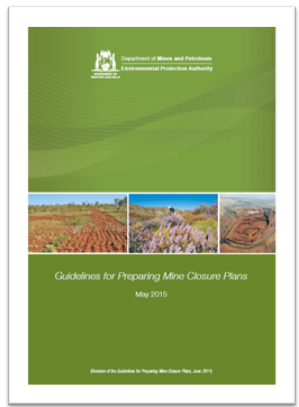
The Department of Mines and Petroleum (DMP) and the Environmental Protection Authority (EPA) jointly released the original “Guidelines for Preparing Mine Closure Plans” (the Guidelines) in 2011.
These guidelines have now been reviewed and a new version has been published and is available on the DMP website. The guideline review addressed feedback received during 2013/14 on the previous version of the Guidelines, while also meeting regulatory requirements.
The new guidelines should be used from 2015 onwards. DMP and the EPA recognise that some operations are required as per tenement conditions to submit the next iteration of their Mine Closure Plans in early 2015. For those companies that are required to submit a Mine Closure Plan in the first half of the 2015 calendar year, and that have already started to prepare the plan, DMP advises that the 2011 Guidelines can be used until September 2015.
If a company is preparing a revised Mine Closure Plan, as per tenement conditions, a full Mine Closure Plan is still required to be submitted. DMP expects the changes between the latest and the previous Mine Closure Plan to be summarised in the Mine Closure Plan checklist (Appendix D) to assist in making the assessment process as efficient as possible.
For a copy of the new guidelines and further information about the review please visit the Mine Closure Guidelines Review section of the DMP website.
If you have any queries please contact your Regional Minerals Team Leader, using the Inspectorate Allocations Map if you are unsure which team leader to contact.
2015 Mining Legislation Amendment Bill
The Department of Mines and Petroleum’s (DMP) Reforming Environmental Regulation Program proposed amendments to the Mining Act 1978 were introduced to Parliament in April 2015. The amendments are aligned with DMP’s risk-based approach to environmental regulation and will take effect once the 2015 Mining Legislation Amendment Bill and relevant supporting regulations are passed.
We are taking notice of some confusion within industry where it is believed that the amendments that are proposed in the Bill will increase regulatory burden. This is certainly not the case. Our expectation is that regulatory burden will be reduced. In simple terms, the proposed amendments will allow DMP to deliver: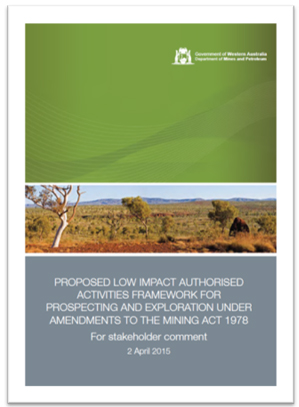
- A smart form system for Programme of Work (PoW), Mining Proposal (MP) and Low Impact Notifications that will be less burdensome to complete and will be much easier for mine operators in the future.
- Development of online lodgement allowing proponents to submit spatial files of their project areas, streamlining the assessment process and eliminating the need for accompanying maps and data entry.
- For mines requiring clearing, proponents will no longer be required to submit both a MP and a native vegetation clearing permit application. This will make it simpler to prepare the MP and greatly reduce lead time.
- Introduction of a Low-Impact Authorised Activities Framework. DMP recognises that small areas of disturbance can be managed with little environmental impact, and that many of these activities do not need an individual environmental assessment. The sorts of activities considered to be potentially low-impact are those associated with prospecting and minor changes to existing projects. Therefore, DMP is proposing to make some activities exempt from the requirement for assessment and instead they will only require a simple notification process.
More detail on the framework can be found in the Proposed Low-Impact Authorised Activities Framework consultation paper.
DMP welcomes all feedback and we will endeavour to answer any questions you may have. Please contact: reform@dmp.wa.gov.au
New website release for DMP
The Department of Mines and Petroleum (DMP) will launch its brand new website in July 2015.
DMP General Manager Communications and Marketing Laura Lewis said the department is currently seeking user feedback on its current website via a short online survey.
“The information will be used as a benchmark to track user satisfaction trends once the new website is launched and gauge how well the new website is meeting stakeholders’ expectations,” Mrs Lewis said.
Director General Richard Sellers said the department has spent three years researching and designing the new website.
“The department is determined to ensure the new website meets the needs and expectations of our stakeholders,” Mr Sellers said.
“The way people access information online has changed in the six years since the current website was launched.
“The new website will be more intuitive and better reflect the way our stakeholders want to use the site.”
The department’s current website was launched in 2009, when the State Government established the Department of Mines and Petroleum in its present form.
“Since 2009 we’ve been adding information to the website in an ad hoc fashion and the current site is essentially designed around the department’s organisational structure,” Mrs Lewis said.
“Our research indicates that this does not reflect how and why people come to the site and as a result many stakeholders find the current website very difficult to navigate.”
Mining Proposal reform update 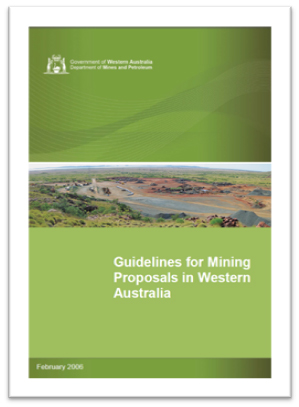
Industry Reference Group for Mining Proposal Reform
Membership of the Industry Reference Group for Mining Proposal Reform was finalised in November 2014. This group is made up of members from industry and the role of this group is to work closely with the Department of Mines and Petroleum (DMP) to develop the shape and content of the new Mining Proposal Guidelines.
The first meeting of this group was held on 25 November 2014, with subsequent meetings held on 18 February 2015 and 26 May 2015. The main discussions during these meetings were around the key changes to the draft Guidelines for Mining Proposals in Western Australia (the Guidelines), including the proposed risk assessment framework, key environmental factors to be considered in the Mining Proposal and associated baseline environmental data.
The draft Guidelines will be released for stakeholder comment following review and incorporation of comments from the Industry Reference Group for Mining Proposal Reform. At this stage, DMP is aiming for the draft Guidelines to be released for stakeholder comment in July 2015. An industry briefing on the proposed changes will be held after the Guidelines are released for stakeholder comment.
Mining Rehabilitation Fund (MRF) update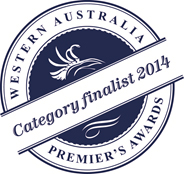
We are fast approaching the close of the second Mining Rehabilitation Fund (MRF) reporting period and we want to remind tenement holders to complete their reports by the 30 June deadline to avoid penalties for failing to report. The MRF team is available to assist you if you have any questions. We also have computers set up in the Library at Mineral House to help assist you with your submissions.
Programme of Work (PoW) data
Tenement holders can already ‘copy forward’ data from an Annual Environmental Report (AER) into the MRF report. We wanted to make reporting easier for tenement holders by extending this functionality to transfer data into the MRF report from approved Programmes of Work (PoW).
When a tenement holder is using the system to complete their 2015 report, approved PoW numbers and the requested hectares will now be displayed in the online wizard. This provides additional information to tenement holders to ensure accuracy in reporting.
New MRF Online Calculator estimates MRF Levy
We previously indicated we would develop an MRF online calculator. We have now released this tool to assist tenement holders to estimate their rehabilitation liability and the levy associated with calculating different disturbances. The calculator also demonstrates how to reduce the levy through progressive rehabilitation of disturbances on the tenement.
The idea for an 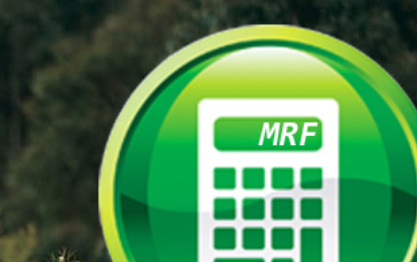 online calculator came from tenement holders in response to DMP’s request in late 2014 for suggestions on how to simplify the annual reporting obligations for the Mining Rehabilitation Fund.
online calculator came from tenement holders in response to DMP’s request in late 2014 for suggestions on how to simplify the annual reporting obligations for the Mining Rehabilitation Fund.
The calculator provides a liability estimate based on the level and type of disturbance, and the amount of rehabilitation that has been conducted on a tenement.
It shows tenement holders how much rehabilitation will save and how much they might reduce levy payments once areas of rehabilitation are completed. As the MRF levy is only calculated on disturbed areas of a tenement, the best way to reduce your future levy payments is through progressive rehabilitation.
The calculator allows tenement holders to enter individual activity types, for example roads or tailings storage facilities, or combine multiple activities into a single Mine Activity Type.
Tenement holders who use the new calculator must still submit their annual MRF disturbance report as the calculator does not enter data into an MRF report; it is only intended to be used for illustrative purposes.
The liability estimate provided is intended to be indicative only and the reliability of its results depends on the accuracy of the disturbance information that’s entered.
The calculator, which was released in April, has so far received positive feedbackand can be accessed via the MRF page on the DMP website.
Renewal reminders
The 2014 MRF reporting period provided the opportunity for DMP to retire bonds when holders made the first levy payment. To ensure the State was not exposed to unacceptable risk, a number of compliance checks were conducted before bonds were retired. This included requests for holders to indicate their intention if tenements were due for renewal within the next 12 months.
Now that the majority of bonds have been retired, an email confirming that the MRF process is complete will be sent to holders once payment for the levy has been received with a reminder that tenements are due for renewal, They will also receive a reminder to complete all rehabilitation requirements before surrendering the tenement.
MRF survey
We have set up a survey to gather responses from tenement holders about a number of potential MRF system enhancements. Please take the time to complete the survey so we can include your ideas. It should take only five minutes.
Survey subjects include:
- Nominated party reporting
- Combining the MRF and AER reporting
- Combining Form 5 requirement into the MRF report
- Infringement Notices
- Additional Disturbance types
Annual audit program
The MRF team undertakes an annual audit program to ensure industry consistently submits accurate data and has a sound understanding of MRF reporting requirements. It is important that industry is aware that all data submitted for the MRF can be audited and it is equally important that DMP has a consistent approach to auditing MRF information.
A total of 174 audits were undertaken by the MRF team for the 2013-14 reporting period and, at this time, 90 per cent of these audits have been successfully closed out. 59 audits found the submitted MRF report had no discrepancies, the remainder required further correspondence and clarification with tenement holders. From this, a number of MRF reports have been edited and amended for greater accuracy. In a couple of cases, a higher levy payment was required.
It is vital that tenement holders communicate and respond to the department’s requests for further information or records in a timely manner.
An analysis will be conducted to identify key groups that are at risk of reporting incorrectly. This will help to determine how audit selection is undertaken and completed in future years, improving efficiency and ensuring greater accuracy of data.
MRF Roadshow
Staff from the MRF team set out on the 2015 roadshow in May this year to assist tenement holders in completing their MRF reports.
The MRF team started at DMP’s Kalgoorlie office, with MRF team manager Sarah Bellamy also visiting the Coolgardie office on the same day. The roadshow included visits to the Leonora and Mount Magnet offices, as well as the shire office at Sandstone.
While members of the MRF team did assist a number of tenement holders to complete their MRF reports, the number of tenement holders who attended was significantly lower than the previous year. While DMP hopes that lack of attendance at this year’s roadshow is a sign that the majority of tenement holders have a sound understanding of how to report for the MRF independently, it does raise some concerns that a portion of holders may be leaving their MRF report to the last minute, or have forgotten that the MRF is a yearly reporting obligation.
Please remember that all tenement holders must report for the MRF using the Environmental Assessment & Regulatory System (EARS2) online system by 30 June each year.
MRF tenement manager and industry forum a success
MRF online reporting forums were held on Wednesday 29 April and Tuesday 26 May with approximately 30 people attending each forum.
The forums explained enhancements to EARS2, the system used to lodge MRF reports, that have been introduced since the last reporting period.
“This is just the second compulsory reporting period for the MRF,” Environmental Reform Manager Sarah Bellamy said.
“We’ve taken on board feedback received last year and introduced a number of enhancements to the online system aimed to streamline the reporting process.”
The forum also included presentations from MRF team members on audits, payments, penalties, bond decisions and the environmental enforcement panel. The forum ended with an extended question and answer session.
“Providing an overview of the MRF cycle often helps tenement managers understand how their role fits into the cycle and the importance of lodging accurate, timely reports,” Ms Bellamy said.
“The question and answer session that closed the forums was also extremely worthwhile as it gave attendees the opportunity to clarify any specific issues they had.
“It was also a great opportunity for us to get feedback from people who use the online system.
“This feedback helps us determine what further improvements we can make to ensure the MRF reporting requirement is as streamlined as possible.
“I think everyone who attended the forum gained a better understanding of the MRF and the online reporting process and the changes since the 2014 reporting period.”
A survey was sent out to all attendees and DMP has already received some very positive feedback.
For further information about upcoming MRF events visit the DMP events page or email MRFenquiry@dmp.wa.gov.au .
MRF Website
The MRF website includes information such as frequently asked questions, a guidance document and step-by-step guide to assist tenement holders with reporting. This, and a lot more information including links to the legislation, is all available on the MRF homepage under the headings ‘Related Links’ and ‘Documents’ in the right hand window pane.
Approvals Performance Report
January - March 2015
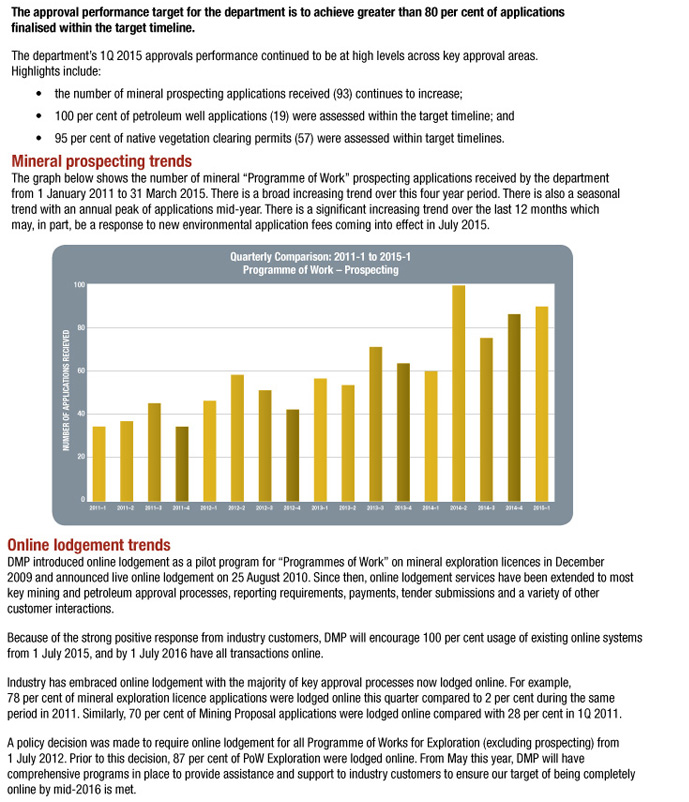
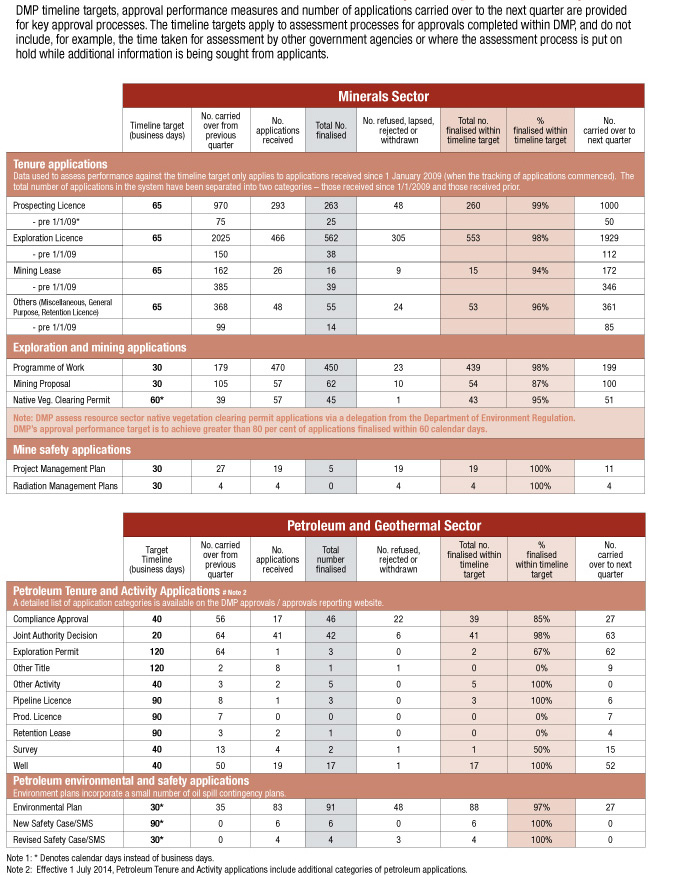
Contact numbers for the Environment Division
Please keep these contact details handy for DMP’s Environment Division.
Minerals assessment or compliance enquiries
The map linked here provides you with the contact details of the DMP Environmental Officers responsible for your inspectorate/mineral field area.
Inspectorate map and responsible Environmental Officers
EARS / EARS 2 online system enquiries
General application and compliance reporting enquiries
Email : EARSManager@dmp.wa.gov.au
Phone : (08) 9222 3535
MRF enquiries
Mining Rehabilitation Fund enquiries
Email : mrfenquiry@dmp.wa.gov.au
Phone : (08) 9222 3162

